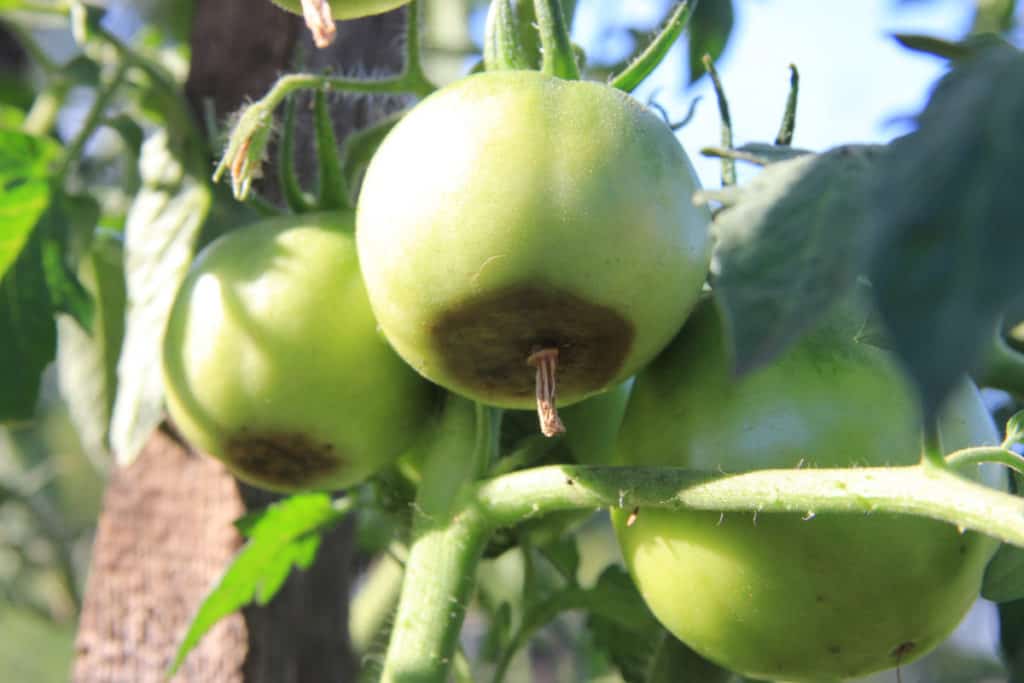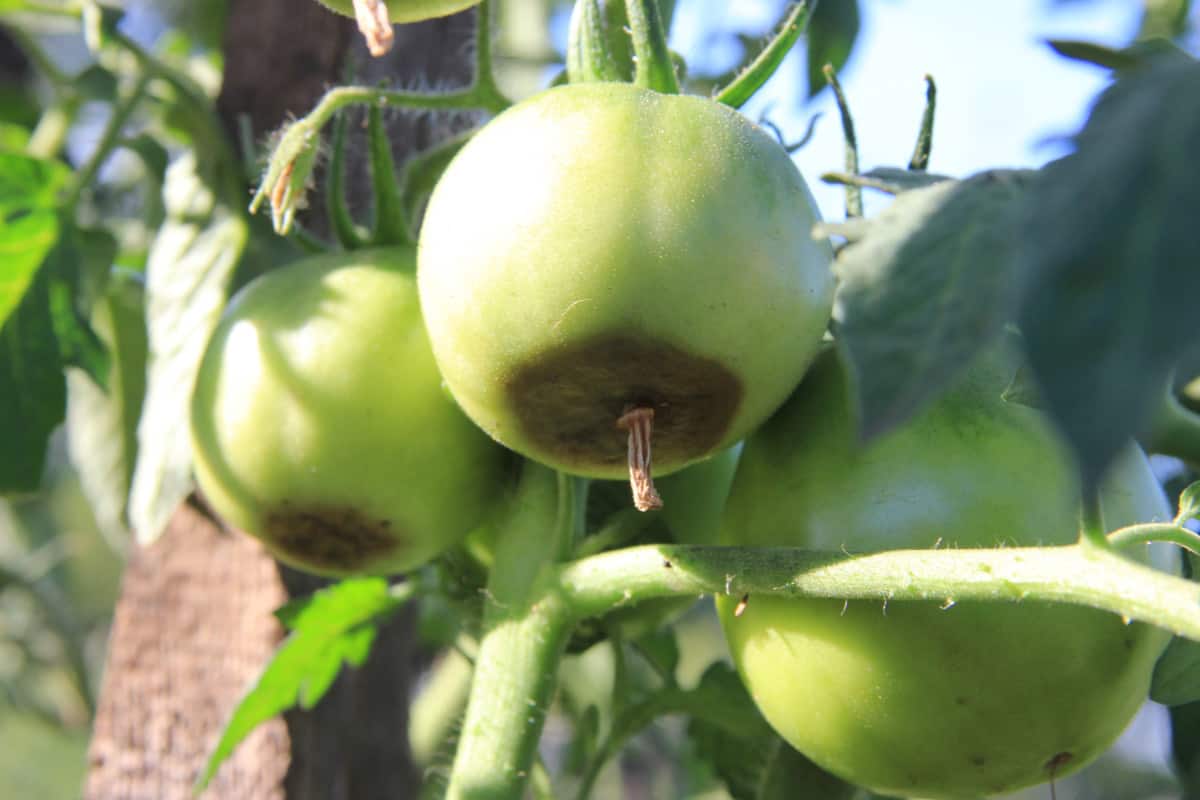Years ago going out to my home garden after heavy rainfall, I noticed the bottoms of some of my green tomatoes had brown spots at the very bottom and I wondered what caused this?
Through my years of experience and research, I will explain the common problem of why your tomatoes turn brown on the bottom and ways to prevent it.
- Why do tomatoes turn brown on the bottom?
- When does Blossom-end rot appear?
- What causes Blossom-end rot on tomatoes?
- 9 Best ways to avoid Blossom-end rot
- What is a good source of calcium for tomato plants?
- Are Indeterminate or determinate varieties more susceptible to Blossom-end rot?
- Can overwatering cause blossom end rot?
- Do eggshells add calcium to the soil?
- What is the fastest way to add calcium to the soil?
- Tomato blossom-end rot home remedy
- Should you cut off tomatoes with blossom end rot?
- Can you treat tomato blossom end rot with Epsom salt?

Why do tomatoes turn brown on the bottom?
Tomatoes turn brown on the bottom due to a lack of calcium in the tomato tissues causing the issue known as Blossom-end rot. This usually appears after heavy rains preceding a dry period of weather causing inconsistent moisture in the soil of the garden bed or container.
This causes the plant to ineffectively supply the available calcium to the fruit due to inconsistent soil moisture levels.
Overwatering your tomato plants after forgetting to do so for a week can also cause blossom-end rot. The key is to make sure the tomato plants are water on a consistent basis by creating a schedule and sticking to it.
When does Blossom-end rot appear?
Blossom-end rot first appears on tomatoes as small water-soaked areas that start to brown, darken and become sunken.
When the tomato plants experience rapid growth early on the plant may not be able to take in calcium quickly enough which is why you generally see (BER) during the early part of the season on some of your first tomatoes.
However, these soaked spots can happen at any time in the growing season as your tomatoes reach maturation.
What causes Blossom-end rot on tomatoes?
Factors that contribute to Blossom-end rot include over applying nitrogenous fertilizer, planting tomato plants early in cold soil, fluctuations in soil moisture, compacted soil causing a lack of aeration, waterlogged soils, and high soil concentrations of magnesium, ammonium or potassium can reduce calcium uptake.
9 Best ways to avoid Blossom-end rot
- Perform a soil test, you want a soil ph of 6.5 for the best nutrient uptake. You can purchase soil test kits online or at your local garden center.
- Avoid adding fertilizers with too much nitrogen in them.
- Mulch around your tomato plants using hay, straw, leaves, grass clippings, or compost to maintain moisture levels during dry periods.
- Avoid calcium deficiency by adding a quick-release lime to your soil at the beginning of the planting season so the tomato plant roots can absorb the calcium it contains more quickly.
- Plant your tomatoes in an area with good drainage that has loose non compacted soil.
- Apply compost and organic matter to your vegetable gardens at the beginning of the season which will aid a creating a healthy root system for your tomato plants.
- Make sure and water your tomato plants on a schedule to maintain consistent soil moisture levels and uptake of calcium into your plants.
- Grow tomato resistant varieties such as Druzba, Ropreco, Mountain spring, and Magnus
- Don’t plant your tomatoes in cold soil
What is a good source of calcium for tomato plants?
There are several good sources of calcium to amend your soil including the following.
- Placing crushed eggshells in the soil when you plant tomato seedlings will add calcium to your soil. Though it will take time for the eggshells to breakdown and decompose.
- Gypsum also is known as calcium sulfate works in a powdered or granular form. Add one to two pounds per 100 square feet of soil area.
- Dolomite limestone in the pelletized form will add calcium to your soil as well but will raise your soil ph in the short term so if your soil PH is 6.0 or below this is a good option but if it is at 6.5 you should use an alternate source.
- Tomato fertilizers: There are many fertilizers on the market that contain a sufficient calcium amount with my personal favorite being Dr. Earths Tomato and vegetable fertilizer with a 4-6-3 ratio you can find it on Amazon. It works best in soil that already has a good amount of nitrogen in it.
- Calcium foliar sprays: Using calcium nitrate as a water-soluble source can also be used but you usually have to spray 2-3 times a week and they are not always as effective as other methods.
Are Indeterminate or determinate varieties more susceptible to Blossom-end rot?
Determinate varieties are more commonly susceptible to Blossom-end rot compared to indeterminate varieties of tomato fruits. With some popular varies of tomatoes such as Better Beef and Big Boy being more susceptible than others.
Can overwatering cause blossom end rot?
Overwatering can cause blossom-end rot and especially if it has been a while since you last watered your tomato plants. Not watering your plants on a schedule causes inconsistent soil moisture levels leaving your tomatoes susceptible to blossom-end rot.
Do eggshells add calcium to the soil?
Eggshells from hen eggs are a natural calcium supplement that can be added to your soil. It does take time for the eggshells to break down in your soil and allow the tomato plant to uptake the nutrients.
What is the fastest way to add calcium to the soil?
The fastest way to add calcium to the soil is to use dolomitic limestone in a powdered fast-acting form then spread it around the base of your tomato plants and work the lime into the soil.
Tomato blossom-end rot home remedy
You can create a limestone slurry using 2 and a half gallons of water and pelleted lime putting in 1 or 2 handfuls of the pelleted lime per gallon. You can see the video here for a more in-depth how-to guide.
Should you cut off tomatoes with blossom end rot?
You can cut off the brown part of the tomato and the rest should be safe to eat in most cases.
However, you may just want to remove the tomatoes with BER and throw them in the compost pile which will allow the tomato plant to focus on producing new tomato fruit.
Can you treat tomato blossom end rot with Epsom salt?
Epsom salt contains magnesium and sulfur. You should not treat blossom-end rot with Epsom salt as it contains no calcium which is the cause of blossom-end rot along with inconsistent soil moisture levels.
Conclusion
Seeing the bottom of your tomatoes browning is never a welcome sight but hopefully you can use these types to prevent or reduce the problems in the future. Happy harvesting.

